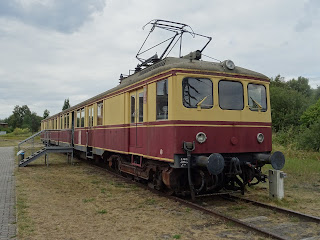This commemorates the escape of these 10 Soviet PoWs in Feb '45. A pilot (forced-)labouring near the airfield noticed that some aircraft were kept fuelled and ready to go at short notice. He and his comrades overcame their guard, flew the plane over the front and managed to land despite being shot at by Sov fighters. The pilot was highly awarded but 6 of the group were killed fighting before the end of the war. [There is so much not said in the former E. Germany. In this example, why were they sent back to the front? Many prisoners were considered traitors - were these?]
A 1:1 model of an A-4/V-2.
A real train used to move people to and around the complex, then later used elsewhere in Germany.
A V-1, also tested here in Peenemunde
A model of launch site VII which we visited yesterday
View from the top of the power station that now houses the Technical Museum.
Massive hoppers to feed coal to the furnaces.
The main questions posed by the museum were whether the rocket testing can be seen as a scientific endeavour with weapons as a by-product or a weapons testing site that exploited PoW labour but happened to help us into space? Were scientists such as Wernher von Braun partially responsible for the deaths of 20,000 forced labourers, or were those deaths due to the way others implemented the requirements of the scientists? Wernher von Braun was feted in the West. Was that right?
I think I do get fixated on the technology of the V-2, and its supposed role in the birth of space travel while ignoring the human cost and also sidelining the ultimate purpose for the rocket, which was to rain explosives on an enemy. (Or to blow up enemy aircraft and ships. An interesting fact is that more people died making these weapons than were ever killed by them when used as weapons.) I am certainly not alone in that convenient fixation: I noticed it when I was visiting the submarine pens, which I could admire as an engineering marvel while sidelining the purpose or human cost entirely. As a perhaps minor illustration, we happily followed our guide around lumps of blown up concrete denoting the various launch pads, but we never visited the PoW camp, and I don't recall any mention of that human cost of the programme. (To be fair, perhaps we missed that because our German isn't great.)
OK, here's a bit of engineering with no such baggage:
With perfect timing we arrived just as it lifted so joined a queue waiting to cross. It lifts rail and road.
Camp this night was in a carpark in Dargun.








No comments:
Post a Comment